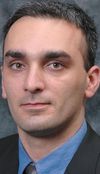Hand hygiene and skin care product company GOJO Industries is working with vendors of Wi-Fi-based RFID tags to create hand-washing compliance solutions that organizations could use to automatically track their staff members’ usage of GOJO’s Purell hand sanitizer, to ensure that hands have been properly disinfected. The solutions will allow hospitals, for example, to monitor hand-washing compliance to reduce hospital-acquired infections (HAI). The systems could also be used at medical clinics and food-handling sites.
Two options—one using AeroScout‘s hardware and software, the other, using Ekahau‘s—will be marketed and sold by their respective RFID technology companies, with GOJO providing its dispensers with the appropriate built-in hardware. The RFID-enabled systems are designed to help hospitals create a record of hand-washing compliance and also send alerts to individuals when they attempt to meet with a patient without washing their hands. Initially the technology will be trialed in U.S. hospitals although the RFID-enabled systems can be sold internationally.
GOJO invented the Purell instant hand sanitizer in 1988 for use by food-service and health-care providers for situations when people lacked access to soap and water. The company reacquired the Purell brand from Johnson & Johnson in October 2010, after having previously sold it to the Warner Lambert division of Pfizer in 2004. At about the same time it reacquired the Purell brand, the company approached both AeroScout and Ekahau for a Wi-Fi based solution to work with GOJO’s new SmartLink series of sanitizer dispensers.
“Today, everyone understands the importance of hand hygiene in providing basic patient care,” says Shawn Warthman, GOJO’s compliance systems director. “However, despite the advancement of the U.S. health care over the past 50 years, very little has been accomplished in terms of improving the degree of hand hygiene compliance.” According to the Centers for Disease Control and Prevention, the average nationwide compliance rate at health-care facilities is at 35 to 40 percent. In an effort to address this problem, GOJO asked both AeroScout and Ekahau to design a system around their existing RTLS technology. “We’re excited about this solution because of the robust platforms these leading RTLS vendors provide for monitoring hand hygiene,” says Warthman.
Hand-hygiene compliance has been an ongoing challenge for U.S. hospitals, which must follow guidelines from the CDC and Joint Commission requiring that alcohol-based rubs, traditional soap and water and sterile gloves are used to protect patients as they are treated in hospitals. This is done most commonly by employing staff specifically to monitor hand hygiene activity of their coworkers.
The Ekahau solution includes an Ekahau T301BD tag embedded in a staff badge, while the GOJO SmartLink Series Dispensers come with a built-in Ekahau location beacon. First, the user waves her hands under the dispenser. That action triggers the unit to dispense the sanitizer and at the same time transmit an IR signal that wakes up the Ekahau badge. The badge then transmits its unique ID number to the hospital’s Wi-Fi nodes, which then send that data to the Ekahau RTLS server, explains Antti Korhonen, Ekahau president and CEO. In this way, if someone washes her hands with the Purell solution, the badge transmits that event to the back-end software which links the individual’s unique ID number with his or her name, and location of the dispenser, and updates the status of the individual as having washed his or her hands. The very fact that the individual placed her hands under the dispenser, which automatically dispenses the solution, provides confirmation that she received the hygiene solution at which point it she would need to rub it into her hands.
If two people wearing badges stood near the dispenser, however, the system could receive transmissions from both badges. “In the future, a more narrow beam can be considered if this becomes a real issue,” Korhonen says. Still, he adds, typically if two people stand in front of the dispenser and one washes her hands, in most cases the other will follow suit.
Later, when the individual then walks into a patient room, the system detects that person’s arrival with an accuracy of several meters, and searches the staff member’s status to determine whether she recently washed her hands. If she has not, the system sends an alert to the badge, causing the badge to vibrate and display a text message on its screen telling the employee to wash her hands. The display can also provide other information to a staff member, such as “thank you for washing your hands” and “Your compliance number [rate] is…,” indicating how often the staff member has complied with hand-washing rules.
The Ekahau RTLS control software calculates the location of the tags as well as manages the communication with badges, including the transmitting of messages regarding hand-washing compliance. In addition, Ekahau Vision is another software layer that hospitals can use to run reports and receive information such as compliance statistics.
Hospitals that already use GOJO’s Purell dispensers would need to add the IR beacon module to operate with the Ekahau system.
If the hospital requires greater granularity, such as when a doctor approaches a bed in a large room, smaller read zones can be created with Ekahau’s battery-powered IR beacons that—in this case—would transmit a unique identifier repeatedly at preset intervals. The badge would capture the unique identifier of that IR beacon and transmit that identifier along with its own ID number, enabling the software to determine the location of the individual within a meter or less.
AeroScout has developed its own AeroScout Hand Hygiene Compliance Monitoring Solution to add onto its existing MobileView RTLS solution. Like the Ekahau system, it provides its hospitals with details of when staff members wash their hands. In this case, staff members wearing AeroScout’s Wi-Fi-based T2 tags would first approach the dispenser and place their hands under the dispenser. The dispenser would have a built in AeroScout 125 KHz RF exciter that transmits a unique ID number at regular intervals, explains Gabi Daniely, VP of marketing and product strategy. Its transmission wakes up the T2 tag being worn by the employee, which captures the ID number of the dispenser exciter and then transmits its own unique ID number as well as that of the exciter to the Wi-Fi nodes installed in the proximity. The MobileView software then receives that data and interprets the individual’s identity based on the badge number, as well as the location based on the exciter ID, and links that data with the time and date. Daniely says that by setting the exciter transmission range to the vicinity immediately in front of the Purell dispenser, AeroScout has reduced the risk of reading any RFID tags worn by other people standing nearby.
When the individual then enters a patient room, the software seeks the history of the staff member’s hand-washing activity, determines whether the hands were recently washed, and then stores the hand-hygiene compliance or lack of compliance in the software record, which can be provided to management. In this case of the AeroScout solution, the software is not designed to send alerts directly to badges worn by staff members when they enter a patient room.
“The key thing infection control managers are looking for is to watch trends, to see if the technology has improved compliance,” says Daniely. The system is capable of sending alerts, he says, for example via e-mail or text message to management, but, says Steffan Haithcox, AeroScout’s senior director of marketing, “that’s not what hospitals want; they want the educational piece,” or reports listing compliance rates. He points out that hospitals traditionally employ live individuals to track hand-washing compliance, and they are not instructed to alert staff when they don’t wash their hands, but rather simply maintain a record.
Both technology vendors indicate that the demand for better hand-washing compliance solutions is high among health-care companies. AeroScout will beta-test its solution in April (there are no pilots underway yet), says Daniely, and then commercially release following those tests, but health-care companies have already been contacting AeroScout to learn more about the solution. “This is a very timely topic in health-care right now,” says Haithcox. With the use of the technology, Daniely speculates, users “will see the compliance rates go up and the infection rates go down. Those are going to be nice results to be contributing to.”
Ekahau is piloting the system now, says Korhonen, at unnamed hospitals, and the company’s version of the technology will be available in March. For hospitals, he says, the system should increase hand washing compliance rate of its staff.
Ekahau, AeroScout and GOJO are not the first companies to offer RFID-enabled hand-hygiene systems. In 2007, Resurgent Health and Medical introduced an RFID-based option for its automated hand-washing systems (see RFID Debuts as Hand-Washing Compliance Officer). Last year, Princeton Baptist Medical Center, in Birmingham, Al., being using Proventix‘s hand-hygiene monitoring solution, which includes battery-powered RFID tags and readers developed by Synapse Technologies (see RFID-based Hand-Hygiene System Prevents Health-care Acquired Infections).



